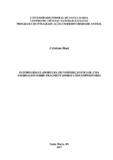| dc.creator | Biasi, Cristiane | |
| dc.date.accessioned | 2018-05-29T15:43:46Z | |
| dc.date.available | 2018-05-29T15:43:46Z | |
| dc.date.issued | 2017-02-21 | |
| dc.identifier.uri | http://repositorio.ufsm.br/handle/1/13268 | |
| dc.description.abstract | According to the River Continuum Concept, in small rivers, corresponding to ~ 80% of river basins, the main energy source for the trophic chain is the material produced in riparian zones, especially leaves. This material goes through the process of decomposition, which is responsible for the nutrients cycling and maintenance of aquatic communities. In this context, the objective of this study is to investigate the effects of physical, chemical and physiological traits of plant species on microbial activity and fragmentation, and as a consequence on decomposition rates. In the first chapter we investigated the activity of Phylloicus fragmentation in relation to food resources with different leaf traits. We found that the shredders have their food activity stimulated by substrate with less amount of lignin, which facilitates fungus conditioning and promotes the palatability of the detritus. In the second chapter, we investigated the feeding preference and assimilation of C3 and C4 carbon by Phylloicus and Aegla longirostri. We found that the shredders consume more the C4 species, but do not alter its isotopic signature and the intense activity of the hyphomycetes in the leaves C4 stimulated the consumption by the shredders. In the third chapter we investigated the effect of nutrient enrichment on soil and water on leaf nutritional quality and decomposition rates. We showed that the fertilized trees promoted leaves more nutritious than leaves of unfertilized trees. In addition, we found that the effect of nutrient enrichment on water was stronger than the nutrient enrichment of leaves in the decomposition process. Within the three chapters, we verified that the activities of the shredders and fungi are influenced by the characteristics of the leaves and are related to the riparian vegetation, especially by C3 carbon. We verified that the structural compounds are determinant for the microbial colonization and consequently for the fragmentation and litter decomposition. We also verified that the enrichment of nutrients in the water may be more important for the process of leaf decomposition than the nutrients in the leaves. | eng |
| dc.description.sponsorship | Coordenação de Aperfeiçoamento de Pessoal de Nível Superior - CAPES | por |
| dc.language | por | por |
| dc.publisher | Universidade Federal de Santa Maria | por |
| dc.rights | Attribution-NonCommercial-NoDerivatives 4.0 International | * |
| dc.rights.uri | http://creativecommons.org/licenses/by-nc-nd/4.0/ | * |
| dc.subject | Aegla longirostri | por |
| dc.subject | Hifomicetos | por |
| dc.subject | Enriquecimento de nutrientes | por |
| dc.subject | Phylloicus | por |
| dc.subject | Vegetação ripária | por |
| dc.subject | Enrichment of nutrients | eng |
| dc.subject | Hyphomycetes | eng |
| dc.subject | Phylloicus | eng |
| dc.subject | Riparian zones | eng |
| dc.title | Fatores reguladores da decomposição foliar: uma abordagem sobre fragmentadores e decompositores | por |
| dc.title.alternative | Regulator factors of leaf breakdown: an approach on shredders and decomposers | eng |
| dc.type | Tese | por |
| dc.description.resumo | De acordo com a teoria do Contínuo Fluvial, nos pequenos rios florestados, que correspondem a ~80% das bacias hidrográficas, a principal fonte de energia para a cadeia trófica é o material produzido nas zonas ripárias, especialmente folhas. Este material passa pelo processo de decomposição, que é responsável pela ciclagem de nutrientes e manutenção das comunidades aquáticas. Neste contexto, o objetivo deste estudo é investigar os efeitos dos traços físicos, químicos e fisiológicos das espécies vegetais na atividade de microrganismos e invertebrados decompositores, e como consequência nas taxas de decomposição. No primeiro capítulo investigamos a atividade de fragmentação de Phylloicus frente a recursos alimentares com características foliares diferentes. Nós constatamos que os fragmentadores têm sua atividade alimentar estimulada por substrato com menor quantidade de lignina, o que facilita o condicionamento por fungos e promove a palatabilidade do detrito. No segundo capítulo, investigamos a preferência alimentar e assimilação C3 e C4 por Phylloicus e Aegla longirostri. Constatamos que os fragmentadores consomem mais a espécie C4, porém não alteram sua assinatura isotópica. E a intensa atividade dos hifomicetos nas folhas C4 estimulou o maior consumo pelos fragmentadores. No terceiro capítulo investigamos o efeito do enriquecimento de nutrientes no solo e na água na qualidade nutricional das folhas e nas taxas de decomposição. Evidenciamos que as plantas fertilizadas geraram folhas mais nutritivas que as não fertilizadas. Além disso, averiguamos que o efeito do aumento de nutrientes na água foi mais forte do que o efeito de nutrientes das folhas no processo de decomposição. Com os três capítulos verificamos que as atividades dos fragmentadores e fungos são influenciadas pelas características das folhas e estão relacionadas com a vegetação ripária, especialmente por carbono C3. Constatamos que os compostos estruturais são determinantes para a colonização microbiana e por consequência para a fragmentação e decomposição foliar. Verificamos também que o enriquecimento de nutrientes na água pode ser mais importante para o processo de decomposição foliar do que os nutrientes nas folhas. | por |
| dc.contributor.advisor1 | Santos, Sandro | |
| dc.contributor.advisor1Lattes | http://lattes.cnpq.br/2397252405405950 | por |
| dc.contributor.referee1 | Moretti, Marcelo da Silva | |
| dc.contributor.referee1Lattes | http://lattes.cnpq.br/3547610267125711 | por |
| dc.contributor.referee2 | Restello, Rozane Maria | |
| dc.contributor.referee2Lattes | http://lattes.cnpq.br/2842573490163132 | por |
| dc.contributor.referee3 | Albertoni, Edélti | |
| dc.contributor.referee3Lattes | http://lattes.cnpq.br/2527146511218001 | por |
| dc.contributor.referee4 | Kotzian, Carla Bender | |
| dc.contributor.referee4Lattes | http://lattes.cnpq.br/6605877914229435 | por |
| dc.creator.Lattes | http://lattes.cnpq.br/4428955127295238 | por |
| dc.publisher.country | Brasil | por |
| dc.publisher.department | Ciências Biológicas | por |
| dc.publisher.initials | UFSM | por |
| dc.publisher.program | Programa de Pós-Graduação em Biodiversidade Animal | por |
| dc.subject.cnpq | CNPQ::CIÊNCIAS BIOLÓGICAS | por |
| dc.publisher.unidade | Centro de Ciências Naturais e Exatas | por |



